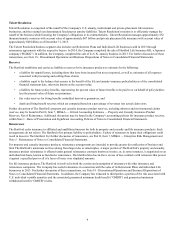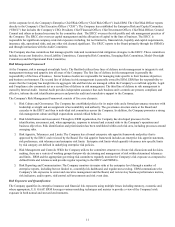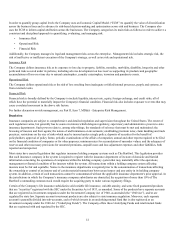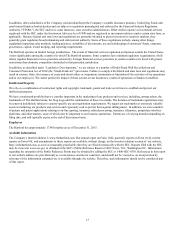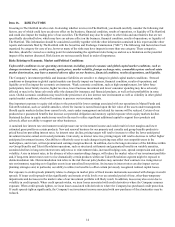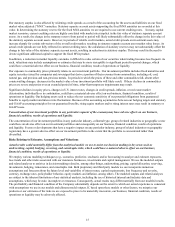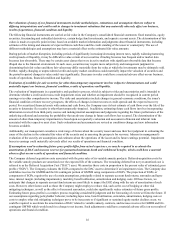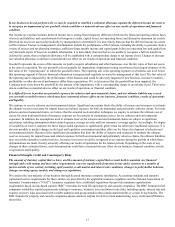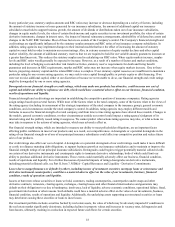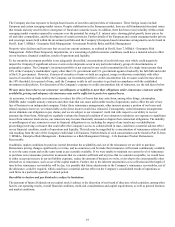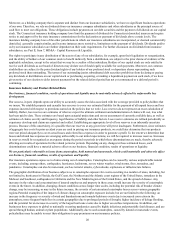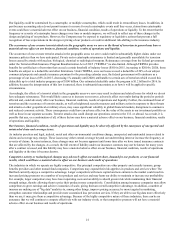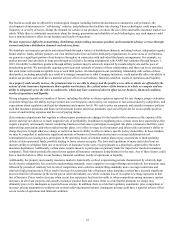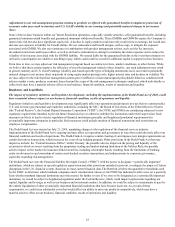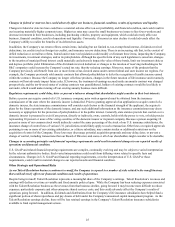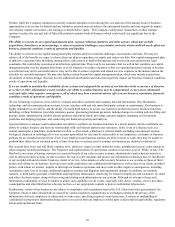The Hartford 2015 Annual Report Download - page 16
Download and view the complete annual report
Please find page 16 of the 2015 The Hartford annual report below. You can navigate through the pages in the report by either clicking on the pages listed below, or by using the keyword search tool below to find specific information within the annual report.
16
Our valuations of many of our financial instruments include methodologies, estimations and assumptions that are subject to
differing interpretations and could result in changes to investment valuations that may materially adversely affect our business,
results of operations, financial condition and liquidity.
The following financial instruments are carried at fair value in the Company's consolidated financial statements: fixed maturities, equity
securities, freestanding and embedded derivatives, certain hedge fund investments, and separate account assets. The determination of fair
values is made at a specific point in time, based on available market information and judgments about financial instruments, including
estimates of the timing and amounts of expected future cash flows and the credit standing of the issuer or counterparty. The use of
different methodologies and assumptions may have a material effect on the estimated fair value amounts.
During periods of market disruption, including periods of significantly increasing/decreasing interest rates, rapidly widening/narrowing
credit spreads or illiquidity, it may be difficult to value certain of our securities if trading becomes less frequent and/or market data
becomes less observable. There may be certain asset classes that were in active markets with significant observable data that become
illiquid due to the financial environment. In such cases, securities may require more subjectivity and management judgment in
determining their fair values and those fair values may differ materially from the value at which the investments may be ultimately sold.
Further, rapidly changing or unprecedented credit and equity market conditions could materially impact the valuation of securities and
the period-to-period changes in value could vary significantly. Decreases in value could have a material adverse effect on our business,
results of operations, financial condition and liquidity.
Evaluation of available-for-sale securities for other-than-temporary impairment involves subjective determinations and could
materially impact our business, financial condition, results of operations and liquidity.
The evaluation of impairments is a quantitative and qualitative process, which is subject to risks and uncertainties and is intended to
determine whether a credit and/or non-credit impairment exists and whether an impairment should be recognized in current period
earnings or in other comprehensive income. The risks and uncertainties include changes in general economic conditions, the issuer's
financial condition or future recovery prospects, the effects of changes in interest rates or credit spreads and the expected recovery
period. For securitized financial assets with contractual cash flows, the Company uses its best estimate of cash flows over the life of the
security to determine if a security is other-than-temporarily-impaired. In addition, estimating future cash flows involves incorporating
information received from third-party sources and making internal assumptions and judgments regarding the future performance of the
underlying collateral and assessing the probability that an adverse change in future cash flows has occurred. The determination of the
amount of other-than-temporary impairments is based upon our quarterly evaluation and assessment of known and inherent risks
associated with the respective asset class. Such evaluations and assessments are revised as conditions change and new information
becomes available.
Additionally, our management considers a wide range of factors about the security issuer and uses their best judgment in evaluating the
cause of the decline in the estimated fair value of the security and in assessing the prospects for recovery. Inherent in management's
evaluation of the security are assumptions and estimates about the operations of the issuer and its future earnings potential. Impairment
losses in earnings could materially adversely affect our results of operations and financial condition.
If assumptions used in estimating future gross profits differ from actual experience, we may be required to accelerate the
amortization of DAC and increase reserves for guaranteed minimum death and withdrawal benefits, which could have a material
adverse effect on our results of operations and financial condition.
The Company deferred acquisition costs associated with the prior sales of its variable annuity products. Deferred acquisition costs for
the variable annuity products are amortized over the expected life of the contracts. The remaining deferred but not yet amortized cost is
referred to as the Deferred Acquisition Cost (“DAC”) asset. We amortize these costs in proportion to the present value of estimated gross
profits (“EGPs”). The Company evaluates the EGPs compared to the DAC asset to determine if an impairment exists. The Company also
establishes reserves for GMDB and the life contingent portion of GMWB using components of EGPs. The projection of EGPs, or
components of EGPs, requires the use of certain assumptions, principally related to separate account fund returns, surrender and lapse
rates, interest margin (including impairments), mortality, benefit utilization, annuitization and hedging costs. Of these factors, we
anticipate that changes in separate account fund returns are most likely to impact the EGP, along with the rate of amortization of such
costs. However, other factors such as those the Company might employ to reduce risk, such as the cost of hedging or other risk
mitigating techniques, as well as the effect of increased surrenders, could also significantly reduce estimates of future gross profits.
Estimating future gross profits is a complex process requiring considerable judgment and the forecasting of events well into the future. If
our assumptions regarding policyholder behavior, including lapse rates, benefit utilization, surrenders, annuitization, hedging costs or
costs to employ other risk mitigating techniques prove to be inaccurate or if significant or sustained equity market declines occur, we
could be required to accelerate the amortization of DAC related to variable annuity contracts, and increase reserves for GMDB and life-
contingent GMWB which would result in a charge to net income. Such adjustments could have a material adverse effect on our results of
operations and financial condition.





